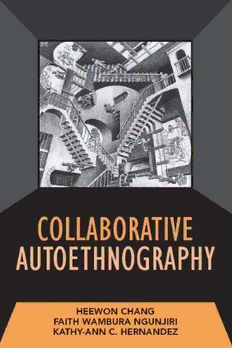
Collaborative Autoethnography PDF
Preview Collaborative Autoethnography
Collaborative autoethnography DEVELOPING QUALITATIVE INQUIRY Series Editor: Janice Morse university of utah books in the new Developing Qualitative Inquiry series, written by leaders in qualitative inquiry, will address important topics in qualitative methods. targeted to a broad multidisciplinary readership, the books are intended for mid-level/advanced researchers and advanced students. the series will forward the field of qualitative inquiry by describing new methods or developing particu- lar aspects of established methods. Series Editorial Board h. russell bernard, Kathy Charmaz, D. Jean Clandinin, Juliet Corbin, Carmen de la Cuesta, John engel, Sue e. estroff, Jane gilgun, Jeffrey C. Johnson, Carl Mitcham, Katja Mruck, Judith preissle, Jean J. Schensul, Sally thorne, John van Maanen, Max van Manen Volumes in this Series: 1. Autoethnography as Method, heewon Chang 2. Interpretive Description, Sally thorne 3. Developing Grounded Theory: The Second Generation, Janice M. Morse, phyllis noerager Stern, Juliet Corbin, barbara bowers, Kathy Charmaz, and adele e. Clarke 4. Mixed Method Design: Principles and Procedures, Janice M. Morse and linda niehaus 5. Playbuilding as Qualitative Research: A Participatory Arts-based Approach, Joe norris 6. Poetry as Method: Reporting Research Through Verse, Sandra l. Faulkner 7. Duoethnography: Dialogic Methods for Social, Health, and Educational Research, Joe norris, richard D. Sawyer, and Darren e. lund, editors 8. Collaborative Autoethnography, heewon Chang, Faith Wambura ngunjiri, and Kathy-ann C. hernandez Collaborative autoethnography Heewon Chang Faith Wambura Ngunjiri Kathy-Ann C. Hernandez Walnut Creek, California leFt CoaSt preSS, inC. 1630 north Main Street, #400 Walnut Creek, Ca 94596 http://www.lCoastpress.com Copyright © 2013 by left Coast press, inc. All rights reserved. no part of this publication may be reproduced, stored in a retrieval system, or transmitted in any form or by any means, electronic, mechanical, photocopying, recording, or otherwise, without the prior permission of the publisher. iSbn 978-1-59874-555-9 hardback iSbn 978-1-59874-556-6 paperback iSbn 978-1-61132-781-6 institutional ebook iSbn 978-1-61132-680-2 consumer ebook library of Congress Cataloging-in-publication Data: Chang, heewon, 1959- Collaborative autoethnography / heewon Chang, Faith Wambura ngunjiri, Kathy-ann C. hernandez. p. cm.— (Developing qualitative inquiry vol.8) includes bibliographical references and index. iSbn 978-1-59874-555-9 (hardback : alk. paper) — iSbn 978-1-59874- 556-6 (pbk. : alk. paper) — iSbn 978-1-61132-781-6 (institutional ebook) — iSbn 978-1-61132-680-2 (consumer ebook) 1. ethnology—authorship. 2. ethnology—research. 3. ethnology—Methodology. i. ngunjiri, Faith Wambura, 1973- ii. hernandez, Kathy-ann C., 1968- iii. title. gn307.7.C43 2012 305.8'00723—dc23 2012024594 printed in the united States of america ∞ ™ the paper used in this publication meets the minimum requirements of american national Standard for information Sciences—permanence of paper for printed library Materials, anSi/niSo Z39.48–1992. Contents list of illustrations 7 preface 11 Chapter 1. What is Collaborative autoethnography? 17 autoethnography 18 autoethnography and Collaborative autoethnography 21 Collaborative autoethnography 23 benefits of Collaborative autoethnography 25 Challenges of Collaborative autoethnography 30 Conclusion 35 Chapter 2. typology of Collaborative autoethnography 37 the Size of research teams 37 the extent of Collaboration 40 Modes of Collaboration 43 Methodological variations of Collaborative 46 autoethnography Conclusion 52 Chapter 3. getting ready for Collaborative autoethnography 55 Forming a research team 55 Deciding on a research Focus 62 Selecting a Collaboration Model 67 Defining roles and Setting boundaries 69 Conclusion 71 Chapter 4. Data Collection 73 Collection of Diverse Data 73 personal Memory and archival Data 75 Self-observational Data 77 Self-reflective and Self-analytical Data 78 Conversational and interactive Data 86 Data Collection Strategies 87 Conclusion 93 Chapter 5. Data analysis and interpretation 95 Data organization and Management 95 logistical Considerations for Data analysis 98 and interpretation Data analysis 101 to use CaQDaS or not, that is the Question 109 Data interpretation 110 Conclusion 113 Chapter 6. Collaborative autoethnographic Writing 115 the Writing Challenge 115 the Collaborative Writing paradigm 117 pre-Collaborative autoethnography Writing 118 Collaborative autoethnography Writing 123 post-Collaborative autoethnography Writing 131 Conclusion 134 Chapter 7. applications of Collaborative autoethnography 137 practice in the Classroom 137 building Community 142 research as activism 145 tool for Critical Work 146 professional Development 147 Conclusion 148 epilogue: our approach 151 the beginnings 151 planning our Data Collection 152 Collaborative autoethnography Writing 153 in retrospect 157 notes 159 references 161 appendix a Writing prompts used for individualized 171 Data Collection appendix b article: “exemplifying Collaborative 175 autoethnographic practice via Shared Stories of Mothering” by geist-Martin et al. index 189 about the authors 199 Illustrations Figures Figure 1-1 Autoethnography continuum 19 Figure 1-2 Common dimensions of AA/CAE 22 Figure 1-3 The iterative process of collaborative 24 autoethnography Figure 4-1 An example of a culturegram 80 Figure 4-2 Symbols used for a kinsgram (Chang, 2008, p. 83) 81 Figure 4-3 An example of a kinsgram (Chang, 2008, p. 84) 82 Figure 4-4 An example of a sociogram 83 Figure 4-5 A constellation of social relationships 84 Figure 4-6 A Venn diagram of our similarities and differences 85 Figure 4-7 The sequential model of data collection 91 Figure 5-1 Micro-coding example 105 Figure 5-2 Relationships among codes, categories, and themes 106 Tables Table 2-1 Comparison among various collaborative 47 autoethnographic approaches Table 4-1 Autoethnographic data types 74 Table 6-1 CAE supporting member tasks and responsibilities 122 Table 6-2 Prominent typologies of collaborative 125 autoethnography writing to each of our husbands Klaus, Chas, and Mark our Collaborators in life
